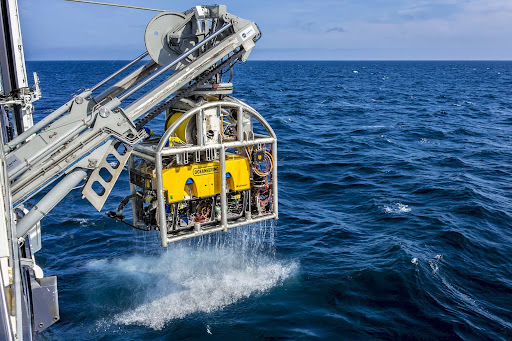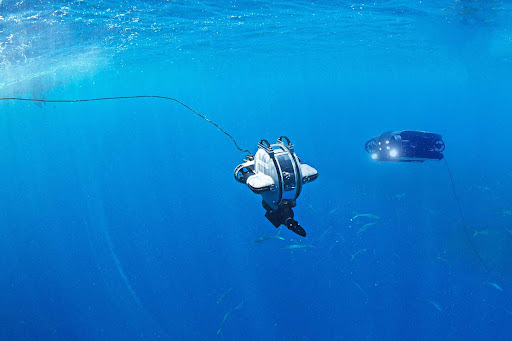Configure Now
Items in Your Cart0
0Items in Your Cart
Start building your packageShop Now

The largest of its kind, a work class ROV is a massive vehicle capable of working at depths over 20,000ft. These vehicles require a heavy lift system for deployment into the water, and are generally equipped with multi-function manipulators to complete complex tasks underwater. Their size and power makes it possible for them to retrieve, deploy, or adjust large objects. Work class ROVs are most commonly used for offshore drilling, construction, or pipeline inspection.
 In an effort to bridge the gap between work and observation class ROVs, light-work class ROVs are very similar in design and functionality to their work class counterparts, just toned down slightly. When offshore work doesn’t require the deepest depths or largest payloads, light-work class ROVs act as a slightly smaller and more affordable alternative, although a mechanical lift will still be required for deployment.
In an effort to bridge the gap between work and observation class ROVs, light-work class ROVs are very similar in design and functionality to their work class counterparts, just toned down slightly. When offshore work doesn’t require the deepest depths or largest payloads, light-work class ROVs act as a slightly smaller and more affordable alternative, although a mechanical lift will still be required for deployment.
 An observation class ROV is drastically smaller in size than either of the work class options. Capable of being deployed by hand, these vehicles are adept for inspections where portability is favored over work capabilities. Operating on either battery or direct power hookups, these vehicles can still perform mild mechanical work, yet are oftentimes portable enough to be transported via commercial airlines.
An observation class ROV is drastically smaller in size than either of the work class options. Capable of being deployed by hand, these vehicles are adept for inspections where portability is favored over work capabilities. Operating on either battery or direct power hookups, these vehicles can still perform mild mechanical work, yet are oftentimes portable enough to be transported via commercial airlines.
Interested in learning more? Click here for more information on underwater ROVs
Regular inspections are crucial for ensuring the structural integrity, water quality, compliance with regulations, and safety of water storage and distribution systems, such as water tanks and towers. Traditionally, these inspections involved manual climbing, rappelling, or confined space entry by hired divers, which was time-consuming, expensive, and risky. Alternatively, tanks had to be drained, resulting in the loss of clean water.
However, in recent years, inspections using remotely operated vehicles (ROVs) have gained popularity due to their safety, efficiency, cost-effectiveness, and accuracy. ROVs can thoroughly examine the interior of water tanks and towers, identifying issues like leaks and corrosion, while providing visual feedback.
Using ROVs mitigates the need for divers, reducing costs and downtime. It enables early detection of problems, reducing the need for extensive repairs. ROVs also minimize the risk of water contamination and can capture detailed images and videos for accurate documentation and analysis of the tank or tower's condition.
Ensure Optimal Water Tank Maintenance with Effective Inspection and Cleaning. Discover Best Practices and Essential Tools in This Comprehensive Guide
Regular hull inspections are important for maintaining optimal ship operations and preventing leaks. Traditionally, dry-docking or hiring divers are costly and time-consuming methods for inspections. However, using remotely operated vehicles (ROVs) has proven to be the most efficient and cost-effective approach.
ROVs can be deployed quickly and navigate the submerged areas of the ship, capturing high-definition images and video to identify cracks, defects, and biofouling. They can transmit live video feeds for real-time decision-making and provide historical data for optimizing inspection schedules. ROVs can also integrate with manipulators for repairs and assist divers in pre-survey assessments, reducing underwater time and risks to divers.
Unlock the Key Insights for Effective Underwater Hull Inspections: Explore Essential Components, Advanced Survey Techniques, and the Game-Changing Role of ROVs.
Regular inspection and maintenance of hydroelectric dams are vital for safe and efficient operation. Traditional methods of hiring divers for inspections are costly, time-consuming, and risky, often requiring reservoirs to be drained. However, the use of remotely operated vehicles (ROVs) has revolutionized the process, offering diver safety, cost-effectiveness, and efficiency.
ROVs can be quickly deployed to inspect water management systems, access confined spaces, assess structural integrity, and monitor gate operation. With high-definition cameras, ROVs provide clear visuals of structures and identify risks, focusing on critical inspection points. The collected data can be utilized to track maintenance and optimize inspection schedules.
Explore the Key to Efficient Water Intake Maintenance: Discover How Underwater Drones Revolutionize Inspections, Saving Time, Money, and Mitigating Risks.
Power plant tanks and intake structures require internal inspections to assess integrity and prevent debris blockage. These confined spaces pose risks for human navigators during maintenance.
ROVs enable safe inspections of cooling water intakes, discharge systems, and submerged structures without system shutdown. Manipulator tools aid divers, reducing their underwater time. Real-time transmission of temperature and pressure data optimizes maintenance and inspection schedules. Regular inspections facilitate monitoring of small defects over time and prioritize timely repairs, reducing costs and avoiding neglected inspections due to high diver expenses.
Discover Cutting-Edge Innovations for Power Plant Inspection and Maintenance: Deep Trekker's Impactful Presentation at the ASME Robotics Conference.
The offshore oil and gas industry is investing in underwater technology, specifically ROVs, to enhance and maintain physical infrastructures and meet challenges like emissions targets and digitalization.
Regular inspections using ROVs address weak points and small leaks in older structures before they escalate into larger issues. Pipeline inspection reports enable effective asset monitoring and cost-effective forecasting of routine repairs. This approach improves efficiency and enhances personnel safety.
ROVs equipped with imaging systems like 4K cameras or sonar allow inspectors to examine pipelines, detect abnormalities, and facilitate repairs without human divers. ROVs can also assist divers by conducting preliminary surveys to ensure their safety, identifying entanglement hazards, dangerous aquatic life, and structural defects that may require further examination.
ROVs quickly detect corrosion, misalignment, and damage in subsea cables and pipelines—without costly downtime or diver risk.
ROVs offer a safer and more efficient alternative to traditional dive teams in search and recovery missions. By working alongside dive teams, ROVs can locate objects, assess structure stability, and provide real-time data for rapid underwater assessment.
Equipped with 4K cameras, sonar, and mission planner software, ROVs enable faster and more accurate SAR operations. They excel in navigating murky water environments, providing visual detail through sonar imaging, assisting in large area searches with waypoint setting and path tracking, and enhancing the safety and efficiency of police missions in collaboration with dive teams.
Unlock the Key to Success in Search and Recovery Missions: Discover the Comprehensive Overview to Find Your Ideal ROV, Powered by Deep Trekker's Cutting-Edge Robots
Marine salvage operations, from sunken personal crafts to large cargo ships, require meticulous attention and adherence to best practices for safe vessel removal. The use of specially designed underwater exploration ROVs equipped with HD cameras has become common in recreational diving and discovery expeditions to mitigate risks to divers.
In commercial and salvage diving, ROVs and divers work together synergistically rather than replacing each other. ROVs enable access to risky or confined areas, retrieval of valuable assets, and assistance in hazardous material removal. Integration of tools like side scan sonar enhances target identification and seabed surveying, allowing divers to work more safely and efficiently underwater by providing them with faster target and area localization.
Mitigate Risks in Salvage Diving: Discover How ROVs Are Revolutionizing Safety Measures and Ensuring a Safer Environment for Divers.
Operating a successful aquaculture farm involves considering various critical factors, including fish feed, net integrity, pen location, and water quality. Traditional methods of regular inspections can be expensive and time-consuming due to the need to hire divers. However, these challenges can be effectively addressed by using ROVs.
ROVs can be quickly deployed, allowing for regular inspections without disturbing the fish population or interrupting farm operations. They enable operators to assess fish health, water quality, equipment functionality, and monitor underwater infrastructure, cages, and nets. With additional tools like mort pushers, net patch kits, and manipulator claws, operators can also perform minor repairs and maintain a clean farm environment by directing morts or removing them from the cages.
Unleash the Power of Underwater Robotics in American Aquaculture: Discover How They Revolutionize Water Quality Monitoring, Boost Fish Health, and Enhance Farm Efficiency.
To prevent costly mistakes and emergencies, thorough and accurate inspections are essential for contractors and municipalities. Traditional methods, such as digging up areas for pipe access are destructive, expensive, and time-consuming.
The use of pipe crawler ROVs revolutionizes the inspection process by enabling non-destructive inspections that are faster, more cost-effective, and safer. These ROVs collect data through video and data recording, mapping, and modeling. They navigate sewage system pipes, assess integrity, detect corrosion, and provide visual data using HD cameras, bright floodlights, and sonar for detailed 3D imaging in low visibility conditions.
Unlock the Power of Pipe Crawlers: Explore Camera Options, Applications, and More in Our Comprehensive Guide to Pipe Inspection Equipment.
ROVs are transforming ocean science by expanding our knowledge of the underwater world and enabling exploration in the vast and ever-changing ocean environment. These powerful tools facilitate the monitoring of marine ecosystems and provide researchers with HD video recordings and imagery of marine life without disrupting wildlife.
Compared to dive teams, ROVs require less equipment and setup time. They are used to monitor marine life populations, investigate invasive species, analyze behavior patterns, and survey aquatic plant life like coral reefs and seaweed beds. Equipped with sensors and manipulators, ROVs can collect water and sediment samples and measure water quality parameters, further enhancing their versatility in scientific research.
Revolutionize Your Ocean Research: Unlock the Potential of ROVs for Advanced Underwater Exploration and Discover the Ideal Drone Setup for Marine Scientists.
Deep Trekker ROVs are highly effective tools for commercial diving operations, providing various features and add-ons to assist dive teams. They excel in salvage tasks, hull inspections, preliminary dive site assessments, and live video feed for diver safety.
Deep Trekker offers four submersible ROVs: DTG3, PIVOT, REVOLUTION, and PHOTON, all designed for versatility and customization. These ROVs are portable, battery-operated, and can be easily transported and deployed in remote locations.
With advanced features like 4K cameras, sonar integration, and durable construction, Deep Trekker ROVs deliver high-quality underwater footage in challenging environments. The DTG3 is a mini observation-class ROV, while the PIVOT and REVOLUTION offer enhanced maneuverability and stability. The PHOTON is a lightweight option with advanced survey capabilities. These ROVs are valuable assets in commercial diving, providing convenience, durability, and adaptability.
Gain a Comprehensive Overview to Find the Ideal ROV for Your Next Project. Make an Informed Purchase Based on Features, Industry, and Budget.
If you need help finding the right technology for your missions, reach out to our robotics experts to find the right option for your applications and budget. We are happy to help. Get your custom quote today.
April 22nd, 2025
FLAIMS 2024 showcased SAR teams integrating ROVs, sonar, and drones, advancing...
April 4th, 2025
Join Deep Trekker and Navtech Radar at Ocean Business 2025 to...
April 3rd, 2025
Advanced ROV training at Deep Trekker Headquarters helped H2O Drones improve...